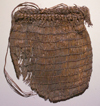
Bayou Jasmine, Louisiana

Views of braided cordage (ca. 1500 B. C.) from Bayou Jasmine; left to right of 4-, 5-, 6-, 7-, 8-, and lO-strand
braids; (on cover) starting end of 8-strand braid.
The Bayou Jasmine archaeological site is located in St. John the Baptist Parish in South Louisiana. Specimens of braided cordage and rhizomes from plants used to produce the cordage were recovered from spoil banks created when a dragline cut through the site during the construction of Interstate 55. Known prehistoric occupations at Bayou Jasmine extend in time from Poverty Point through Mississippian periods or from about 1500 B.C. to A.D. 1400.
This fine cordage is the second oldest, documented cordage remains from Louisiana. It was most likely used in a variety of ways. However, fishing was an important activity that took place at Bayou Jasmine, and cordage often played an important part in prehistoric fishing technology. The cordage may well have served as either a drop line or a trot line.

Twined bag (ca. 800 B. C) from Arnold Research Cave made of unprocessed leaves from the rattlesnake master plant.
![]()
LSU Textile & Costume Museum
140 Human Ecology Building
Department of Textiles, Apparel Design, and Merchandising
College of Agriculture
Louisiana State University
Baton Rouge, LA 70803
Telephone: (225) 578-5992 and 578-2281
Fax (225) 578-2697
Contact us
Arnold Research Cave Missouri | Avery Island and Louisiana | Bayou Jasmine Louisiana | Rattlesnake master plant | Footwear | Photos |Credits | Past Exhibitions